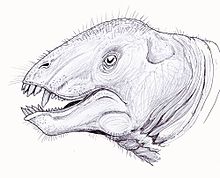Tapinocaninus
| Tapinocaninus Temporal range:
| |
|---|---|

| |
| Scientific classification | |
| Kingdom: | Animalia |
| Phylum: | Chordata |
| Clade: | Synapsida |
| Clade: | Therapsida |
| Suborder: | †Dinocephalia |
| Family: | †Tapinocephalidae |
| Subfamily: | † |
| Genus: | †Tapinocaninus Rubidge, 1991 |
| Species: | †T. pamelae
|
| Binomial name | |
| †Tapinocaninus pamelae Rubidge, 1991
| |
Tapinocaninus is an extinct genus of therapsids in the family Tapinocephalidae, of which it is the most basal member. Only one species is known, Tapinocaninus pamelae (meaning "Pam's humble canine"). Fossils have been found dating from the Middle Permian (Wordian age).
Description[]
It grew up to 3 metres (120 in) long, and massed up to 1,000 kilograms (2,200 lb). It is assumed to be either a herbivore or an omnivore. This dinocephalian has a heterodont dentition, consisting of incisors, canines and postcanines. It's canine teeth lack a definite crushing heel. The maxillary and premaxillary dentition is only partially preserved.
The species is named in honour of Rubidge's mother.[1]
Discovery[]
Fossils have been found in the Eodicynodon Assemblage Zone of the Karoo deposits, in the Lower Beaufort Beds in Beaufort West, by the director of the BPI, Professor Bruce Rubidge. Four specimens are known. A holotype (NMQR 2987) and three paratypes (NMQR 2985, 2986 and ROZ K95). All of them are known from skull and mandible bones.[2]
References[]
- ^ Rubidge, B.S. (1991). "A new primitive dinocephalian mammal-like reptile from the Permian of southern Africa". Palaeontology. 34: 547–559.
- ^ Rubidge, 1991, "A new primitive dinocephalian mammal-like reptile from the Permian of southern Africa" Archived 2013-10-21 at the Wayback Machine
External links[]
- Tapinocephalidae at Kheper
- Tapinocephalians
- Prehistoric therapsid genera
- Wordian genera
- Guadalupian synapsids of Africa
- Fossil taxa described in 1991
- Prehistoric therapsid stubs

